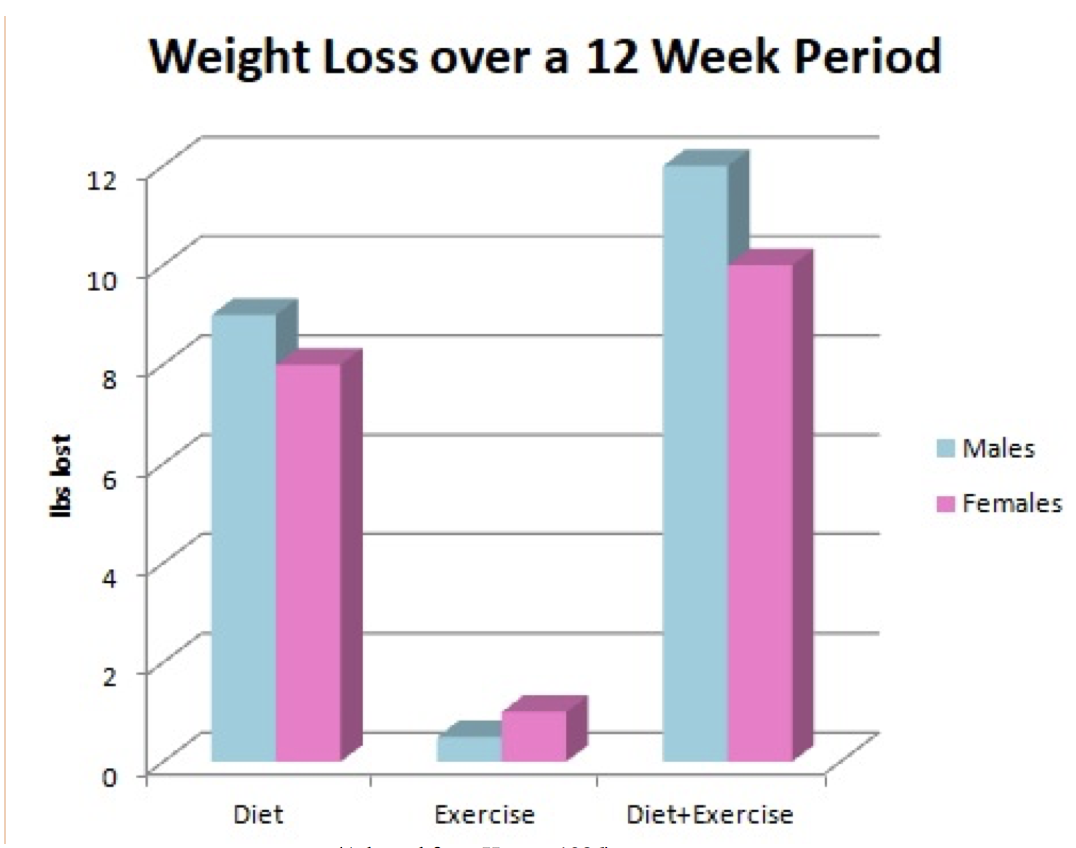Reveal the truth behind cardio training and find out whether it is a good strategy to lose weight.
What you Need To Know
- Standard aerobic exercise (like jogging) has minimal application for fat loss
- Cardio boosts appetite in women
- Calorie requirements for fat loss should not be adjusted for cardio exercise
- The Metabolic Afterburn effect of HIIT is greatly exaggerated in the media
- Excessive cardio decreases overall daily activity.
The Treadmill Paradox
The definition of insanity is doing the same thing over and over but expecting a different result. Unfortunately, this could not be truer for the standard female fat loss protocol. For the majority of women, the fat loss battle is a multiyear process filled with yo-yo dieting and ultimate failure.
In most cases, when a woman decides to lose weight, her first instinct is to go into an extended period of severe calorie restriction, coupled with excessive amounts of steady state aerobic exercise (like jogging). Combined with a minimalistic effort to build muscle and a phobia of “bulky appearance”, the female fat loss workout plan is predominantly based on cardiovascular training with occasional light dumbbell work. Unfortunately this type of approach is counterproductive when trying to achieve fat loss.
Why Cardio Training?
Let me start off by saying that I am not against cardio as a whole. Being active is wonderful and the human body was made to exist in motion. Where things start to fall apart is when people misuse cardio training.
Cardio is not overly effective as a tool for fat loss. This is not a new concept. Studies show that when three groups of people (diet only, diet and cardio, cardio only) start a fat loss program, the weight loss results from the cardio training were statistically insignificant (1).

(Adapted from Hagan, 1986)
Why Does This Happen?
There Are a Few Things to Consider About Cardio for Weight Loss:
1. Cardio Does Not Burn as Many Calories as You Think It Does
This is a common blunder. We have all heard that the treadmill numbers are “estimates”, but so are heart rate monitors.
When I was experimenting with various cardio protocols, I did a simple experiment. I wore my top of the line Garmin to a controlled exercise stress test. My HR monitor overestimated my calories burned by 300%. The technology is not perfect and tends to err on the side of higher calories burned. This effect increases over time as you improve in your sport.
You might have noticed that training gets easier over time – even if you are pushing harder during your intervals or logging extra miles, the “blackout pain” of your first intense cardio workouts is a thing of the past. The more you practice, the more your biomechanics improve for the sport. You become more coordinated, more economic and more efficient. This is great news for your jogging skills, but another nail in the coffin of your fat loss (2).
Not only are you forcing yourself through an activity that you might or might not enjoy, you are contributing a lot less to your fat loss than you think you are. This triggers a cycle of overeating. Tracking apps like MyFitnessPal automatically subtract the calories burned from your exercise plan. The majority of people trying to lose weight are so afraid of under-eating that they continue to “eat back” the calories burned, even if their weight loss stalls. In most cases, since the calories are over-estimated, the calories eaten back simply bring the individual back to their maintenance, stalling their overall progress.
2. Cardio Makes Women Hungry
You might have heard that exercise suppresses appetite. Well, a research team out of Ottawa conducted a study and found that to be true only for men. In women, cardiovascular exercise actually boosted appetite (3). This perpetuates another overeating cycle. A woman goes for a run, her appetite is increased, so she eats. If she eats in excess, frequently she is tempted to “run more to burn off the extra food”. During that attempt, she burns less than she thinks, while continually boosting her appetite. She runs more, eats more, trains harder, gets more fatigued, but sees less results. It’s worth mentioning that walking did not have this effect (4).
3. Cardio is Addictive
Most people fall into two categories when starting cardio training for weight loss. The first group becomes so demotivated by the pain and suffering of the whole experience that their will power runs out. They try cardio for a few weeks, see little or no result and give up altogether.
The second group forces themselves through the grind. They overcome fatigue, the pain signals and the chafing through sheer force of will. Eventually, cardio can cause an interesting effect.
You might have heard of the “runner’s high”. This is a very real phenomenon. In a study by Boecker et al., it was concluded that the body releases opioids after endurance exercise and that these effects cause “addictive aspects of excessive sports, where injured athletes continue their training in spite of detrimental consequences to their health (5).” This means that chasing endorphins makes us forget that we might be hurting ourselves. And it can absolutely make us forget that our goal was weight loss. We become so consumed with chasing that feeling that we completely ignore that the scale has not budged for months. Couple that with a few race medals, bragging rights, some cool tech gadgets, and we are hooked. This makes it very difficult to have our eyes on the prize when trying to lose fat.
3. A Gazelle for an Hour, a Sloth for 23
If you have ever combined a restricted diet with tons of cardio training, you know that the smiling girl on a poster that talks about how running “filled her day with energy” is full of it. Being in a caloric deficit for multiple weeks as you are trying to signal your body to drop fat creates a cascade of responses known as metabolic adaptation. This does not mean your metabolism is breaking, all it means is your body is trying to adapt to the situation you put it in because it doesn’t want to die.
You’re giving it less energy? It’s trying to use less energy. Ever feel like you are colder than normal during a diet? Your body drops your core temperature a touch. Feel like you lost the bounce in your step? Energy preservation. As dieting gets further along, more of these little changes take place, making you progressively more sluggish. Cardio not only speeds up this process, but also gives us a mental excuse. “I went for a run! My workout is done, so I will binge-watch Netflix the rest of the day!” Sound familiar? If you do a cardio workout, which makes you lazy and sluggish for the rest of the day, the small amount of calories you did burn off, gets balanced out by these tiny adaptive changes (6).
5. The Metabolic Afterburn
Recently, HIIT has been greatly popularized with programs such as CrossFit. The concept of burning increased calories while relaxing at home is tantalizing to anyone interested in fat loss. During recovery, the body experiences “Excess Post-Exercise Oxygen Consumption (EPOC)” to return to its resting state. Muscle is repaired, lactic acid is flushed and oxygen stores are replenished. These effects can last up to 48 hours and burn additional calories. However, the EPOC effect of HIIT workouts is greatly exaggerated. In a study that evaluated 3-5 HIIT workouts per week, overall weekly calorie expenditure was boosted by only 200 calories. During fat loss, you might be tempted to take “any calorie you can get”, but keep in mind that the after burn effect of HIIT exercises does not give you a hall pass on your nutrition(7).
So I Shouldn’t Do Any Cardio Ever Again?
As I mentioned before, being naturally active, as a part of your lifestyle, is wonderful and certainly has many health benefits. It’s just cardio training is not an effective tool for fat loss and might be slowing down your efforts. That being said, if there is a cardio activity you love – absolutely do it! Just keep in mind that it has nothing to do with your fat loss journey.
Once your fat loss is complete, cardio training can also be useful if you are trying to maintain your current weight. If you are not in a caloric deficit, the metabolic adaptation cascade is not triggered so you get to “keep” the calories you burned off so you can eat a bit more. However, keep in mind that it is a lot fewer calories than your monitor thinks so it is up to you to decide whether an hour on the treadmill is worth that little extra Booster Juice.
References
- Hagan RD, Upton SJ, Wong L, Whittam J. The effects of aerobic conditioning and/or caloric restriction in overweight men and women. Med Sci Sports Exerc. 1986 Feb;18(1):87-94.
- Barnes KR, Kilding AE: Running economy: measurement, norms, and determining factors. Sports Med Open. 2015;1(1):8.,
- Pomerleau M1, Imbeault P, Parker T, Doucet E..Effects of exercise intensity on food intake and appetite in women.Am J Clin Nutr. 2004 Nov;80(5):1230-6. Available On-line at https://www.ncbi.nlm.nih.gov/pubmed/15531670
- Unick JL1, Otto AD, Goodpaster BH, Helsel DL, Pellegrini CA, Jakicic JM. Acute effect of walking on energy intake in overweight/obese women. Appetite. 2010 Dec;55(3):413-9. doi: 10.1016/j.appet.2010.07.012. Epub 2010 Jul 30.
- Boecker, H. et al. The Runner’s High: Opioidergic Mechanisms in the Human Brain. Cerebral Cortex, Volume 18, Issue 11, 1 November 2008, Pages 2523–2531, https://doi.org/10.1093/cercor/bhn013
- Trexler, Eric & Smith-Ryan, Abbie & Norton, Layne. (2014). Metabolic adaptation to weight loss: Implications for the athlete. Journal of the International Society of Sports Nutrition. 11. 7. 10.1186/1550-2783-11-7.
- Laforgia, J. Withers, R.T., Shipp, N.J. and CJ Gore (1985). Comparison of energy expenditure elevations after submaximal and supramaximal running.J Appl Physiol.1997 Feb;82(2):661-6




